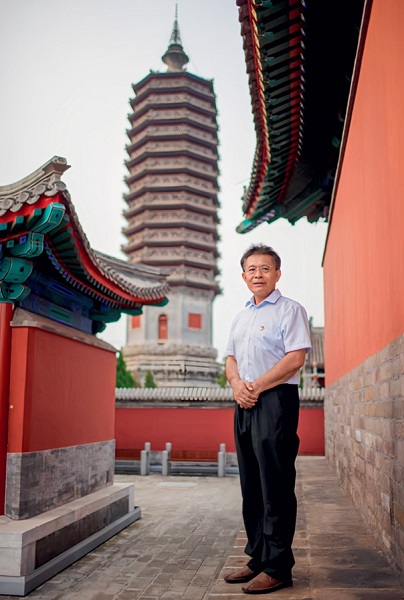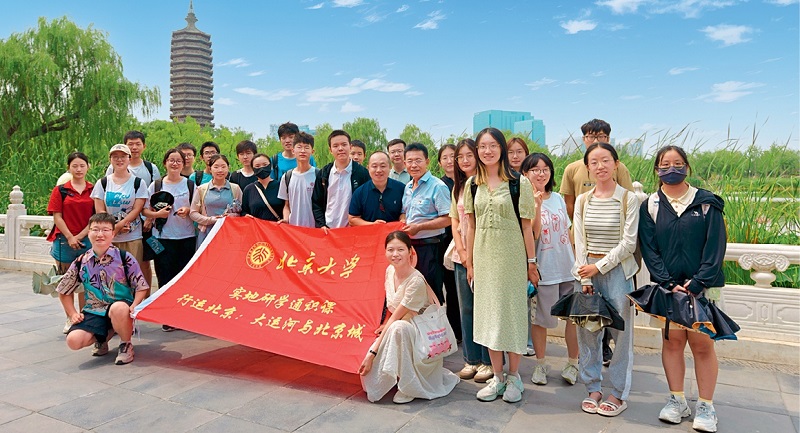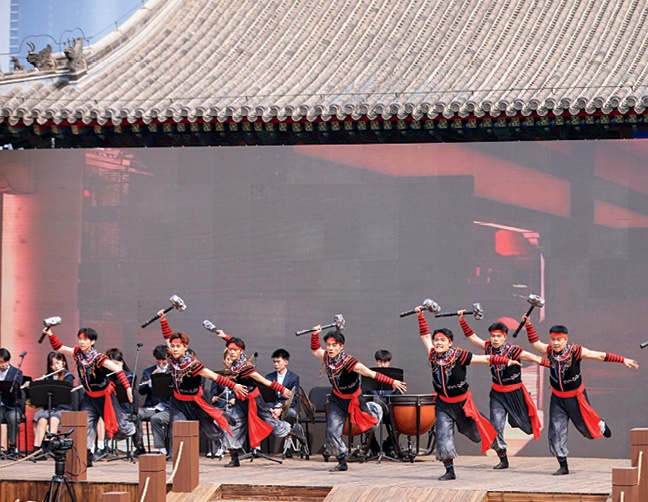A precious heritage from ancient times, the Beijing-Hangzhou Grand Canal has renewed its former glory through ecological rehabilitation and cultural preservation over the past decades.

Ren Deyong pictured in front of the centuries-old Randeng Pagoda. Courtesy of Ren Deyong
June 22, 2025, marks the 11th anniversary of the Beijing-Hangzhou Grand Canal’s inscription on the UNESCO World Heritage list. Looking back on my 20 years working on the canal, I am overwhelmed with emotion after seeing the ancient waterway, and the Beijing section in particular, completely transformed.
The Beijing segment of the canal has been expanded from 50 meters to 200 meters in width, its water has become cleaner, and its banks greener. By 2024, forest coverage on both sides of the canal had reached 33.7 percent, and 367 bird species have been recorded in Tongzhou, the district traversed by the canal, which is the winter home for tens of thousands of water birds every year.
The ancient waterway and the surrounding regions are also hotspots of cultural and leisure activities for local residents. They include marathons, Dragon Boat Festival races, historical reenactment at the Grain Transport Wharf and during Navigation Opening Festival (to celebrate the return of ships as ice melts), as well as performance of the canal-themed musical Tinker Girl and modern drama Northward. Today, visitors from across China and the world are flocking to Tongzhou, Beijing’s municipal administrative center, to experience the Grand Canal’s cultural offerings firsthand.

Ren Deyong and a group of students and teachers from the Peking University during their Grand Canal research tour in Tongzhou, Beijing on June 29, 2024. Courtesy of Ren Deyong
Rise and Fall
For a long period in history, the Beijing-Hangzhou Grand Canal served as a lifeline for imperial grain transport. During the Yuan (1271-1368), Ming (1368-1644), and Qing (1644-1911) dynasties, grains from the south were shipped via the canal to Beijing, capital of all three regimes. The Randeng Pagoda, near the royal Grain Transport Wharf, was the lighthouse used to guide incoming boats, a legacy immortalized in the Qing Dynasty official Wang Weizhen’s poem, “The pagoda, an icon of Tongzhou, casts its lone reflection in the canal.”
Yet after 1901, when the Qing government abolished the 2,000-year-old imperial grain transport system, the Grand Canal gradually fell into decline.
In the summer of 2000, educators in Tongzhou District launched a research tour of the Grand Canal, mobilizing 500 teachers and students from primary and secondary schools across Beijing. The purpose was for the participants to survey the ecological environment and resources along the Tongzhou section of the canal and have a better understanding of the historical significance of the waterway and the wisdom of its builders.
However, the organizers encountered an embarrassing incident. When the enthusiastic students arrived at the northern starting point of the Grand Canal — Dual Sluice Gates at Beiguan in Tongzhou, they refused to get off the bus as the water there was simply too foul!
Pedestrians passing by would cover their noses and hold their breath; cyclists would pedal furiously to speed away; while drivers hurriedly rolled up their windows to avoid the stench. The ancient canal was unapproachable.
This scene would have been unthinkable less than 20 years before, when the China Central Television produced a documentary about the Grand Canal, showing its crystal clear waters. So, what happened in the following two decades? Students of the research group asked me and my colleagues, “The canal water is so smelly and disgusting. What have you been doing to protect it?” This question left us speechless.
The Beijing-Hangzhou Grand Canal is as magnificent as the Great Wall, both standing as monumental engineering feats of ancient China. The Great Wall was inscribed on the World Heritage list as early as in 1987, but the 2,500-year-old Grand Canal had long remained unrecognized.
Like the Grand Canal, the Great Wall had once been fragmented and dilapidated. But a national campaign, starting in 1984, led to extensive restoration and preservation. In contrast, the northern section of the Grand Canal had dried up in many places, with the riverbed clogged with firewood and debris. The stretch from Beijing’s Tongzhou to Tianjin, though still flowing, had been reduced to a mere channel for flood drainage and sewage disposal.
Indeed, the Grand Canal had long lost the grandeur of its heyday, when it served as a vital artery connecting four provinces and two municipalities (Zhejiang, Jiangsu, Shandong, Hebei, Tianjin, and Beijing) and spanned five major river systems (Qiantang, Yangtze, Huaihe, Yellow, and Haihe rivers). After more than a century, its once mighty presence seemed a dim and distant memory.

An event promoting the Grand Canal culture opens in Tongzhou, Beijing, on April 26, 2025.
Rehabilitation and Revival
As a monumental hydraulic engineering feat of China, the Grand Canal epitomizes the wisdom of our ancestors and the spirit of the Chinese nation. It was not only a cardinal shipping route through past dynasties but also a lifeline for people of all ethnic groups living along it.
At the end of 2005, three eminent experts — 82-year-old Luo Zhewen, 90-year-old Zheng Xiaoxie, and 61-year-old Zhu Bingren — jointly presented an open letter to the governments of 18 prefecture-level regions along the Grand Canal, including Tongzhou District, calling for its preservation and World Heritage application. Their impassioned appeal resonated across the nation, galvanizing coordinated action among regions along the canal to strengthen protection and inspiring efforts to pursue World Heritage status.
At that time, I had just been transferred to the Tongzhou District Museum after 15 years of teaching. Though still new to the role, my experience as a middle school history teacher had convinced me that the Grand Canal is a living world heritage site from our ancestors, deserving greater attention.
Today, the Grand Canal has been revitalized. Over the two decades of applying for and ultimately achieving its UNESCO World Heritage status, milestones have been set one after another:
In June 2022, the 62-kilometer Beijing-Hebei section became fully interconnected;
From 2022 onward, the Grand Canal has maintained uninterrupted water flow for four consecutive years. This year alone it was replenished with 500 million cubic meters of water, which is vital for restoring the ecological environment along its route.
In 2023, the Tongzhou Confucius Temple, built in 1298, was opened to the public after three phases of restoration and upgrades. It has since become another attraction in the district’s Grand Canal culture resort, a national 5A scenic area.
Through ecological rehabilitation and cultural preservation, the timeless Grand Canal has entered a new stage of development.
Some people compare the Grand Canal with the Great Wall, both icons of the Chinese nation. This resonates with me, a native of Tongzhou who was born and raised along the canal, and a former teacher who once led students in field studies of this ancient waterway, and a cultural worker who receives visitors to its shores as part of my daily work.
Over the past years, I have personally engaged in major events in the canal's remarkable evolution. These include the launch of the Cultural Heritage Conservation Plan for Humanistic Olympic Games, development of the Grand Canal Cultural Belt, the successful UNESCO World Heritage bid, and national 5A scenic area designation. As visitors from across the world flock to the ancient canal in growing numbers, I feel a stronger responsibility to share its stories with them, presenting this Chinese legacy to a broader world. 
REN DEYONG is a special member of the Chinese People's Political Consultative Conference Tongzhou Committee and former Party secretary of the Tongzhou District Museum.